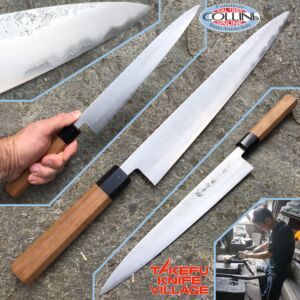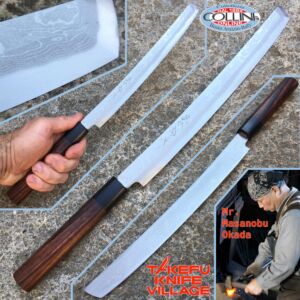Damascus Blade Kitchen Knives: Slice and Cook with Style and Elegance
-
Takefu Village - Takobiki Knife 260mm by Mr. Masanobu Okada - F-276R - kitchen knife
Takefu Knives Village is a brand born in 1991 in Echizen Fukui, a city in Japan famous since 1400 for the production of knives.
The Takefu knives brand is based on the union of 10 local artisans who make each knife by hand.The model presented is made by:
Mr. Masanobu Okada
Born in the city of Echizen in 1949, the third generation of forging artisans, he is one of the few living heirs of the "masaoki-ho" typical of Echizen, a forging technique that consists in hammering and folding the steel giving it a rhomboid shape for get a thinner, sharper and easier to sharpen steel sheet.Initially specialized in the production of agricultural tools with the Monjiro brand, in recent times he began to produce artisanal kitchen knives with the traditional "uchi-hamono" technique, also receiving the title of Dentoukougeishi (traditional craftsman) after having undergone the strict examinations of the commission of the Traditional Crafts Industry Promotion Association Foundation.
The uchi-hamono technique (uchi means blow and hamono means cutting tool) finds its origins towards the end of the 1300s, in the Muromachi period and consists of manually beating with a hammer and repeatedly a heated steel sheet until a blade of cut. Many tools made with this particular method are still on permanent display at the MoMA (Museum of Modern Art) in New York.
In a recent interview Mr. Okada said: "I have been engaged with this art for over 45 years, but still today I still think that it is an infinite world where the notions learned never become obsolete and for this I feel I have to transmit them. to the younger generations ". Currently, under his careful guidance, two apprentices are thoroughly learning the blade polishing techniques.
Characteristics of the knife:Use: meat / fish
Blade: CladSteel carbon steel with cutting edge in White Paper Steel (Shirogami) at 62 / 64HRC and damascus with 67 layers
Provenance Lama: Japanese craftsmanship
Handle: SandalWood, very hard and water resistant wood
Packaging: in cardboard with Japanese writing
Blade length: 265mm
Total length: 410mm
Blade thickness: from 3.5mm to 3mm
Handle Length: 139mm
Weight: 178g* Not every knife is signed on the blade by the craftsman who made it
Maintenance:
Considering the high carbon steel used for the blade and the extreme construction quality of these knives, we recommend a series of attentions to be followed to maintain the quality of the product over time.- Never put the knife in the dishwasher
- Rinse the knife with hot water before first use
- Rinse the knife immediately after each use without aggressive dishwashing detergent and dry with a soft cloth (always starting at the back of the cutting edge)
- Aggressive foods such as lemon juice must be promptly rinsed immediately after use
- Do not use glass or granite plates as a cutting support. Use only wooden bases
- Pay attention that the cutting edge of the knife does not come into contact with other metal objects during its storage to avoid damage to the cutting edge.
Invia commenti
Cronologia
Salvate
CommunityF-276R -
Takefu Village - Sujihiki Knife 270mm by Mr. Kanehiro Kintaro - kitchen knife
Takefu Knives Village is a brand born in 1991 in Echizen Fukui, Japan's famous city since the 1400s for knives production.
The Takefu knives brand is based on the union of 10 local artisans who make every knife by hand.The model presented is made by:
Mr. Kanehiro Kintaro
Kanehiro-san knives have gained popularity among professional chefs for the highest construction level and the high performance and cutting performance.
Knife Features:Use: meat / fish
Blade: Clad Steel (Steel Hammer Forged, San Mai) Steel with Aogami cutting edge super carbon steel core 62 / 63HRC with 3 layers
Origin Knife: Japanese craftsmanship
Handle: Cherry wood
Packing: in cardboard with Japanese writing
Length Blade: 265mm
Total Length: 417mm
Thickness Blade: 4mm to 1mm
Length Grip: 137mm
Weight: 154g* Not every knife is signed on the blade by the craftsman who made it
Maintenance:
Considering the high carbon steel used for the blade and the extreme construction quality of these knives, we recommend a number of attentions to keep in order to maintain the quality of the product over time.- Never put the knife in the dishwasher
- Rinse the knife with hot water before first use
- Rinse the knife immediately after each use without detergent for aggressive crockery and dry with a soft cloth (always starting at the back of the blade wire)
- Aggressive foods such as lemon juice should be rinsed immediately after use
- Do not use glass or granite plates as a cutting support. Use only wooden bases
- Take care that the knife blade wire does not come into contact with other metallic objects during its storage to prevent damage to the blade.D-507 -
Takefu Village - Takobiki Knife 270mm by Mr. Masanobu Okada - kitchen knife
He was born in 1949 and is the 3rd generation of Okada Uchihamono. He is originally a blacksmith of gardening tools such as a sickle. In recent years, he has started to produce unique kitchen knife like your bought Takobiki. The Traditional Craftsman is the so-called Dentoukougeishi (Traditional Craftsman) which is the Accreditation Examination conducted by the Traditional Crafts Industry Promotion Association Foundation in accordance with Section 8 of Section 24 of the Act on Promotion of Traditional Craft Industries
Knife Features:
Use: meat / fish
Blade: CladSteel carbon steel with 62 / 64HRC White Paper Steel (Shirogami) cutting edge and 33-layer Damask "Suminagashi"
Origin Knife: Japanese craftsmanship
Handle: SandalWood, very hard and water resistant
Packing: in cardboard with Japanese writing
Length Blade: 265mm
Total Length: 410mm
Thickness Blade: 3.5mm to 3mm
Length Grip: 139mm
Weight: 162gF-416 -
Takefu Village - Yanagiba Sashimi Knife 270mm by Mr. Hideo Kitaoka - kitchen knife
Mr. Hideo Kitaoka
He was born in 1950 and is the 3rd generation of Kitaoka Hamono. He has been a specialist of Kataba (single-beveled) knife from the beginning. He is also Dentoukougeishi.Use: meat / fish
Blade: CladSteel carbon steel with 62 / 64HRC White Paper Steel (Shirogami) cutting edge and 33-layer Damask "Suminagashi"
Origin Knife: Japanese craftsmanship
Handle: SandalWood, very hard and water resistant
Packing: in cardboard with Japanese writing
Length Blade: 257mm
Total Length: 410mm
Thickness Blade: 4mm to 1.5mm
Length Grip: 139mm
Weight: 184g* Not every knife is signed on the blade by the craftsman who made it
C-804





